Non-domestic rating: Reval 2023 draft list statistical commentary and background information
Updated 6 December 2022
Rateable values are one component of the business rates calculation. These statistics are released alongside the publication of the 2023 draft list, which is part of a wider package of government announcements. For more information refer to the Autumn Statement of 17 November 2022 and Find Your Business Rates.
About this release
This statistical release shows the change in the rateable value of non-domestic properties as a result of the 2023 revaluation, to reflect changes in the property market since the previous revaluation in 2017.
The rateable value determined by the Valuation Office Agency (VOA) provide the basis for national non-domestic (business) rates bills.
This release compares changes between the 2017 rating lists and 2023 draft rating lists by sector and geography as well as the distribution of rateable value of properties.
The revaluation will take effect from 1 April 2023, updated statistics based on the live (2023) rating lists will be published in April 2023.
Responsible Statistician
Sarah Windass
Statistical enquiries
Date of next publication
An updated publication will be published in April 2023.
1. Key findings
The 2023 revaluation has shown an increase in the total rateable value for England and Wales.
1.1 Local list findings
The number of properties on the 2023 draft list in England and Wales at 12 November 2022 was
2.14 million
The total rateable value of these properties was
£70.3 billion
compared to £65.7 billion on the 2017 rating list.
Total rateable value on the local lists for England and Wales increased by
7.1%
Total rateable value for England increased by
7.3%
Total rateable value for Wales increased by
1.3%
In addition:
-
The East region showed a 14.4% increase in rateable value, the largest increase in any region in England.
-
The North East region showed a 2.2% increase in rateable value, the smallest increase in any region in England.
-
The retail sector showed a 10% decrease in rateable value, the only sector to show a decrease.
-
The industry sector showed a 27.1% increase in rateable value, the largest increase in any sector.
1.2 Central list findings
The central rating list contains the rating assessments of the network property of major transport, utility and telecommunications undertakings and cross-country pipelines.
The total rateable value on the 2023 draft central list as at 12 November 2022 was
£3.7 billion
This breaks down into £3.5 billion for England and £0.2 billion for Wales.
Rateable value on the Central lists in England and Wales have decreased by
0.6%
Rateable value for England decreased by
0.7%
However, rateable value for Wales increased by
1.7%
This statistical release aims to compare rateable values of properties which were valued on both the 2017 and 2023 lists.
Some properties have moved between the local and central rating lists between revaluations. Due to differences in the way the VOA accesses local and central rating list data, rateable properties which have moved from the local list to the central list are not included in the comparisons of rateable value in Table 1.1 of this release.
These properties have a total rateable value on the 2023 central rating list of approximately £315 million.
The remainder of this statistical commentary will refer to the local rating list.
2. Contribution to total change in England and Wales in rateable value by each sector
Figure 1: Percentage change that each sector contributes to the total percentage change in rateable value from the 2017 list to the 2023 draft list, England and Wales
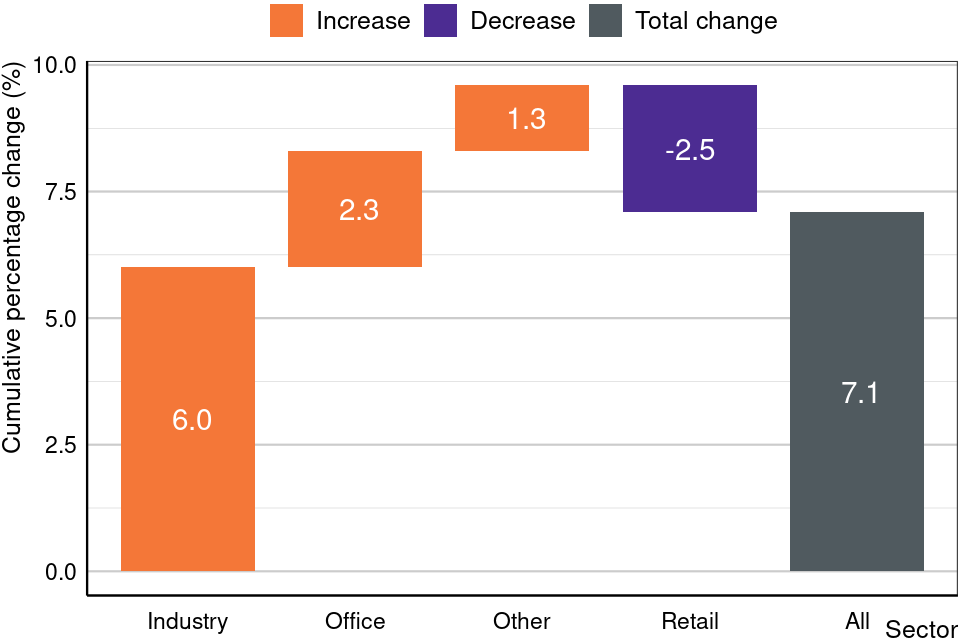
Figure 1: Percentage change that each sector contributes to the total percentage change in rateable value from the 2017 list to the 2023 draft list, England and Wales
Source: NDR Revaluation 2023 (draft list), published November 2022 (Tables 2.0-2.4)
Figure 1 shows the contribution that each sector has made towards the total change in rateable value of 7.1% across England and Wales. The graph shows the percentage increase or decrease each individual sector has made to total rateable value from the 2017 list to the 2023 draft list. Each sector is made up of a similar number of rateable properties, ranging from 437,020 in the office sector to 634,010 in the ‘other’ sector. Despite this, the industry sector makes the greatest contribution to the overall change in rateable value.
3. Total rateable value by sector
This section compares the total rateable value on the 2017 local rating list and the draft 2023 local rating list for each of these sectors in England and Wales.
Figure 2: Total rateable value on the 2017 and 2023 local rating lists by sector, England
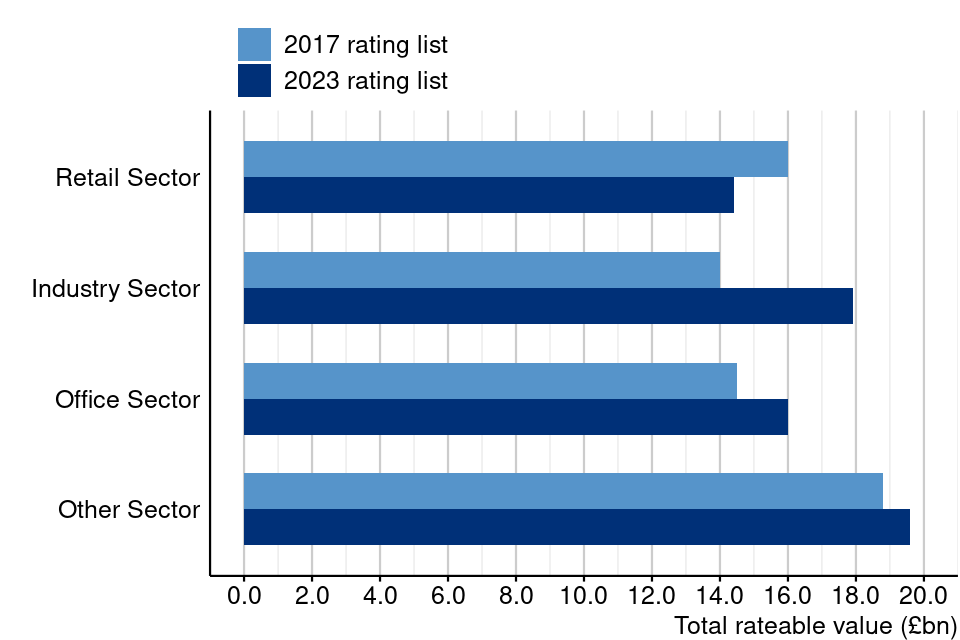
Figure 2: Total rateable value on the 2017 and 2023 local rating lists by sector, England
Source: NDR Revaluation 2023 (draft list), published November 2022 (Table 4.1)
Figure 2 shows the total rateable value (£billions) in England on the 2017 local rating list and the 2023 draft list for each sector.
Figure 3: Total rateable value on the 2017 and 2023 local rating lists by sector, Wales
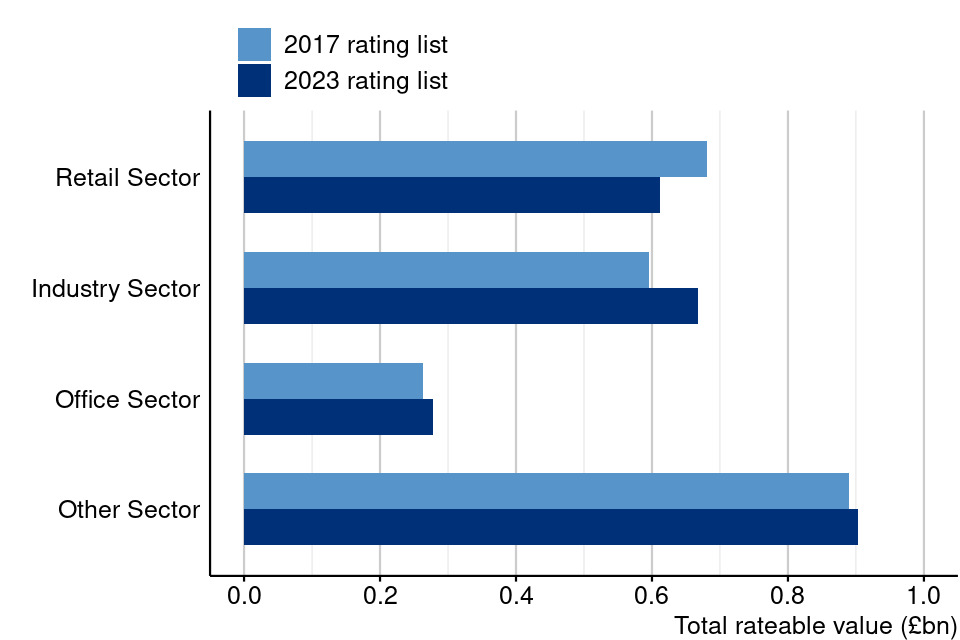
Figure 3: Total rateable value on the 2017 and 2023 local rating lists by sector, Wales
Source: NDR Revaluation 2023 (draft list), published November 2022 (Table 4.2)
Figure 3 shows the total rateable value (£billions) in Wales on the 2017 local rating list and the 2023 draft list for each sector.
4. Percentage change in rateable value by sector
Figure 4: Percentage change in rateable value by sector, England and Wales
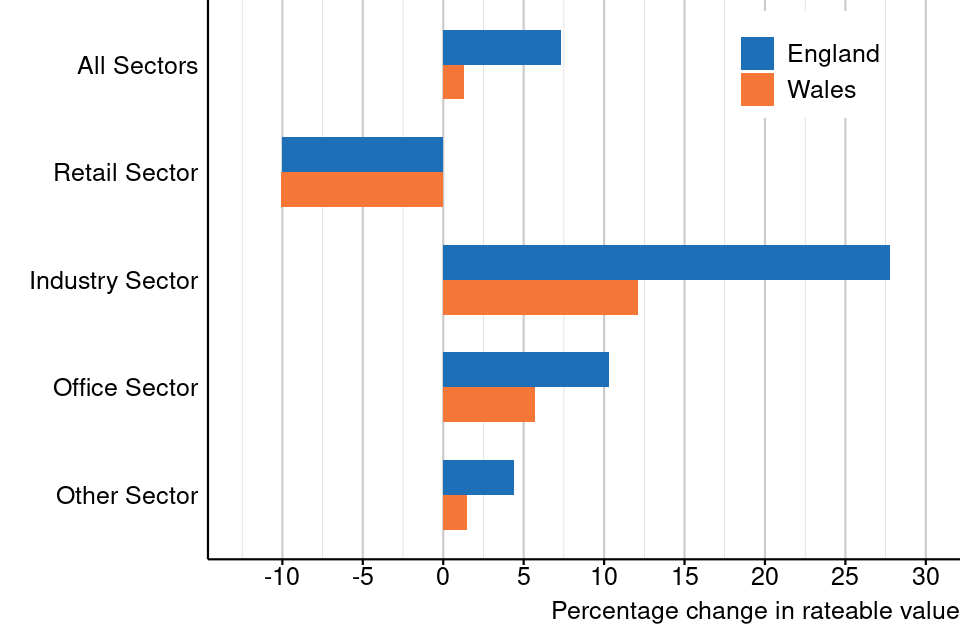
Figure 4: Percentage change in rateable value by sector, England and Wales
Source: NDR Revaluation 2023 (draft list), published November 2022 (Table 1.0)
Figure 4 shows the percentage change in rateable value between the 2017 rating list and draft 2023 rating list for each sector as well as for all sectors in England and Wales.
5. Contribution to total change in England and Wales in rateable value for each region
Figure 5: Percentage change that each region contributes to the total percentage change in rateable value from the 2017 list to the 2023 draft list, England and Wales
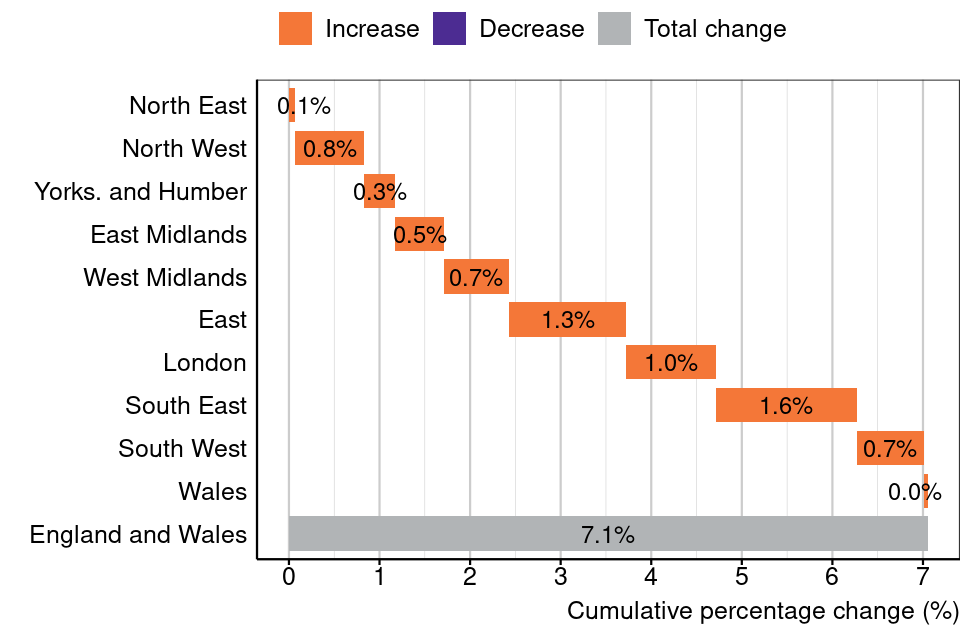
Figure 5: Percentage change that each region contributes to the total percentage change in rateable value from the 2017 list to the 2023 draft list, England and Wales
Source: NDR Revaluation 2023 (draft list), published November 2022 (Table 2.0)
Figure 5 shows the contribution that each region has made towards the total change in rateable value of 7.1% across England and Wales. The graph shows the percentage increase or decrease each individual region has made to total rateable value from the 2017 list to the 2023 draft list.
6. Total rateable value by region
This section compares the total rateable value on the 2017 local rating list and the draft 2023 local rating list for each of these regions in England and Wales.
Figure 6: Total rateable value on the 2017 and 2023 local rating lists by region, England and Wales

Figure 6: Total rateable value on the 2017 and 2023 local rating lists by region, England and Wales
Source: NDR Revaluation 2023 (draft list), published November 2022 (Table 2.0)
Figure 6 shows the total rateable value (£billions) from the 2017 local rating list to the 2023 draft local rating list for each region in England and Wales.
7. Percentage change in rateable value by region
Percentage change in rateable value also varies by region.
Figure 7: Percentage change in rateable value by region, England and Wales
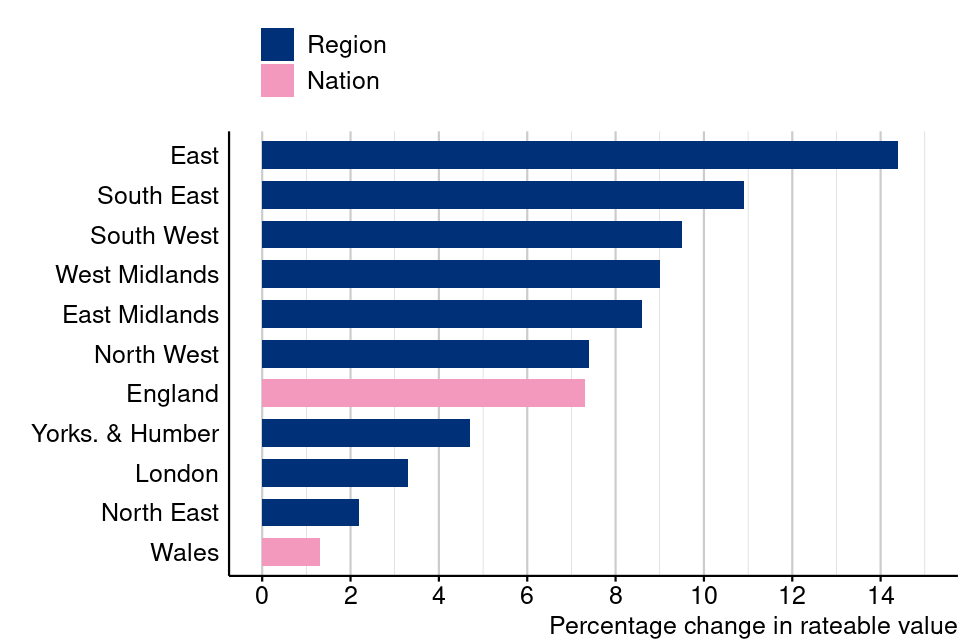
Figure 7: Percentage change in rateable value by region, England and Wales
Source: NDR Revaluation 2023 (draft list), published November 2022 (Table 1.0)
Figure 7 shows the percentage change in rateable value between the 2017 rating list and draft 2023 rating list for each region in England and Wales.
8. Change by rateable value interval
This section breaks down how rateable properties and rateable value are distributed across different rateable value intervals.
Figure 8: Distribution of properties across rateable value intervals on the 2017 and 2023 local rating list, England and Wales

Figure 8: Distribution of properties across rateable value intervals on the 2017 and 2023 local rating list, England and Wales
Source: NDR Revaluation 2023 (draft list), published November 2022 (Table 3.0)
Figure 8 shows the number of properties in each rateable value interval for the 2017 rating list compared with the draft 2023 rating list for England and Wales. This shows that the lowest rateable value interval (£0 - £6,000) has the greatest number of rateable properties while this has decreased between the 2017 rating list and draft 2023 rating list, the number of properties in every other band has increased.
Figure 9.1: Distribution of rateable properties on the 2023 local rating list by rateable value interval, all sectors, England
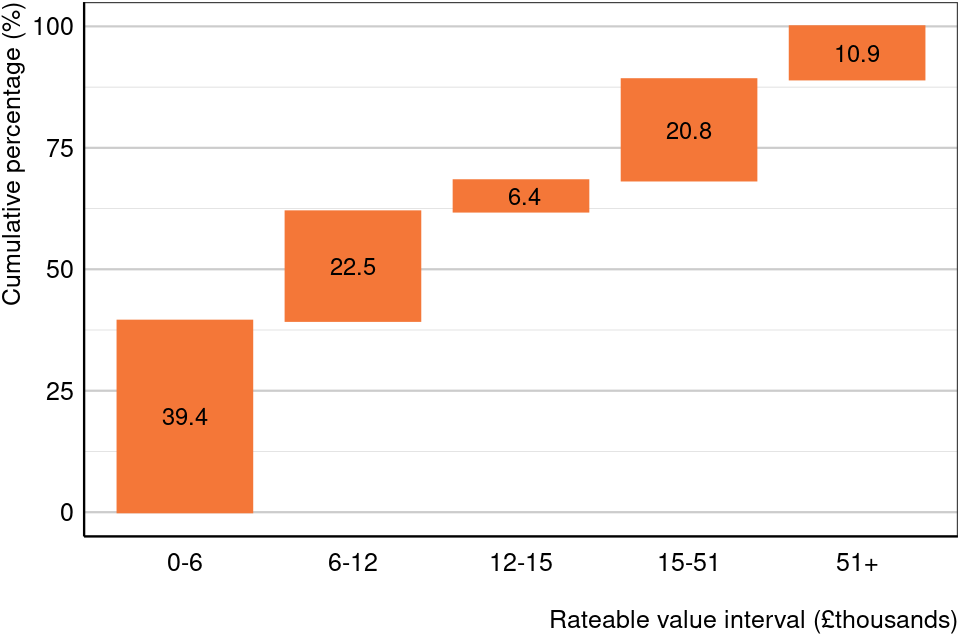
Figure 9.1: Distribution of rateable properties on the 2023 local rating list by rateable value interval, all sectors, England
Source: NDR Revaluation 2023 (draft list), published November 2022 (Table 3.0)
Figure 9.2: Distribution of rateable value on the 2023 local rating list by rateable value interval, all sectors, England

Figure 9.2: Distribution of rateable value on the 2023 local rating list by rateable value interval, all sectors, England
Source: NDR Revaluation 2023 (draft list), published November 2022 (Table 3.0)
Figure 9.1 shows the distribution of rateable properties and Figure 9.2 shows the distribution of rateable value across different rateable value intervals in England on the draft 2023 rating list. Together, these figures show that most rateable properties are in the lower rateable value intervals, but the majority of total rateable value comes from the smaller number properties in the highest rateable value interval (£51,000 and over).
Figure 10.1: Distribution of rateable properties on the 2023 local rating list by rateable value interval, all sectors, Wales

Figure 10.1: Distribution of rateable properties on the 2023 local rating list by rateable value interval, all sectors, Wales
Source: NDR Revaluation 2023 (draft list), published November 2022 (Table 3.0)
Figure 10.2: Distribution of rateable value on the 2023 local rating list by rateable value interval, all sectors, Wales
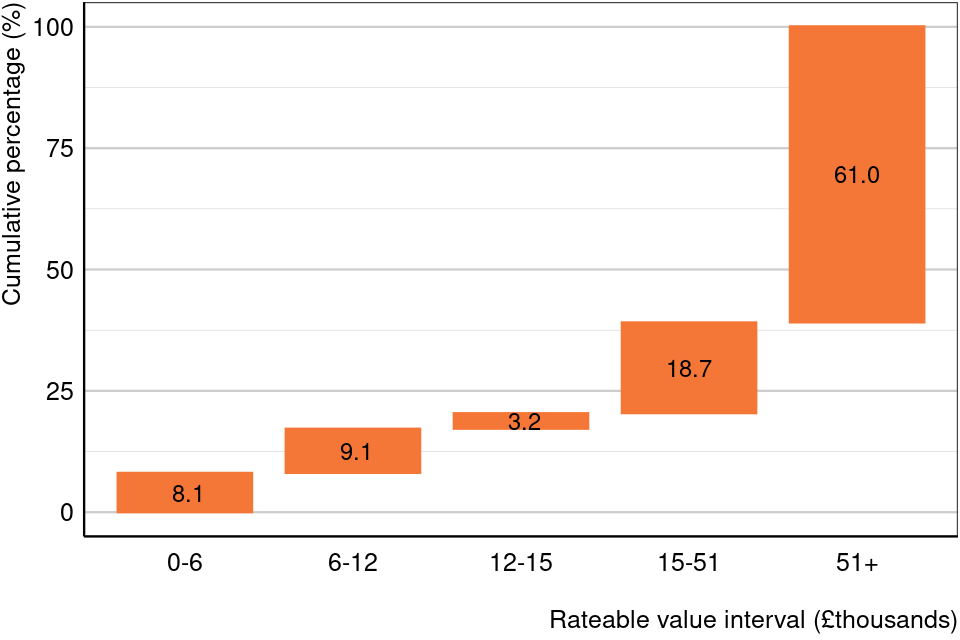
Figure 10.2: Distribution of rateable value on the 2023 local rating list by rateable value interval, all sectors, Wales
Source: NDR Revaluation 2023 (draft list), published November 2022 (Table 3.0)
Figure 10.1 shows the distribution of rateable properties and Figure 10.2 shows the distribution of rateable value across different rateable value intervals in Wales on the draft 2023 rating list. Similar to the England figures, these figures show that while most rateable properties are in the lower rateable value intervals, the majority of total rateable value comes from the smaller number of properties in the highest rateable value interval (£51,000 and over).
Figure 11: Change in rateable value (£billions) by rateable value interval, all sectors, England and Wales
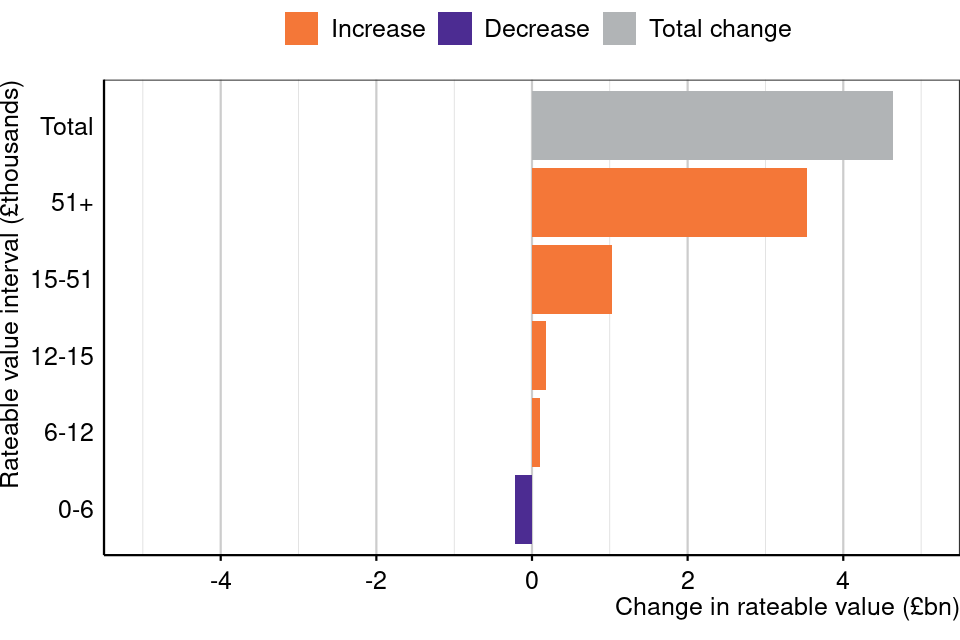
Figure 11: Change in rateable value (£billions) by rateable value interval, all sectors, England and Wales
Source: NDR Revaluation 2023 (draft list), published November 2022 (Table 3.0)
Figure 11 compares changes in total rateable value (£billions) for each rateable value interval with the total change in rateable value for all sectors in England and Wales.
Figure 12: Percentage change in rateable value by rateable value interval, all sectors, England and Wales

Figure 12: Percentage change in rateable value by rateable value interval, all sectors, England and Wales
Source: NDR Revaluation 2023 (draft list), published November 2022 (Table 3.0)
Figure 12 compares percentage changes in total rateable value for each rateable value interval with the total percentage change in rateable value for all sectors in England and Wales.
9. Change within the retail sector
Each sector has certain Special Category (SCat) codes assigned to it, which are operational codes used by the VOA to classify a property’s use. This section breaks down the retail sector by the SCat codes assigned to it and by intervals of rateable value.
Figure 13: Total rateable value for 2023 draft and 2017 local rating lists, retail sector by Special Category (SCat) code description, England and Wales

Figure 13: Total rateable value for 2023 draft and 2017 local rating lists, retail sector by Special Category (SCat) code description, England and Wales
Source: NDR Revaluation 2023 (draft list), published November 2022 (Table 4.0)
Figure 13 compares total rateable value on the 2017 rating list and draft 2023 rating list for the five Special Category (SCat) codes with the greatest total rateable value within the retail sector. These highest value SCat codes have all decreased in rateable value, except for large food stores.
Figure 14: Change in rateable value (£billions) by rateable value interval, retail sector, England and Wales
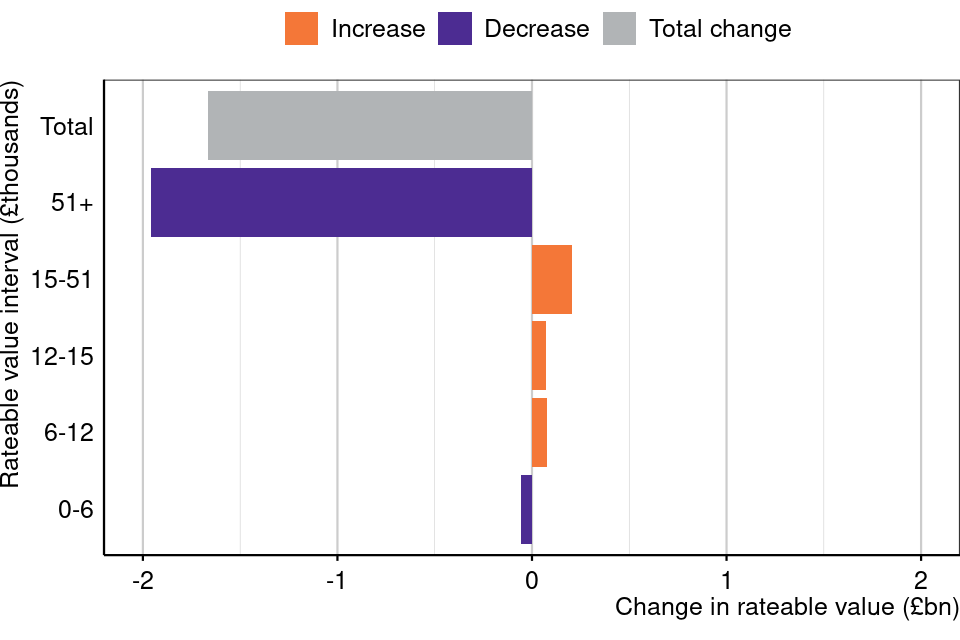
Figure 14: Change in rateable value (£billions) by rateable value interval, retail sector, England and Wales
Source: NDR Revaluation 2023 (draft list), published November 2022 (Table 3.1)
Figure 14 compares changes in total rateable value (£billions) for each rateable value interval with the total change in rateable value for the retail sector in England and Wales.
Figure 15: Percentage change in rateable value by rateable value interval, retail sector, England and Wales
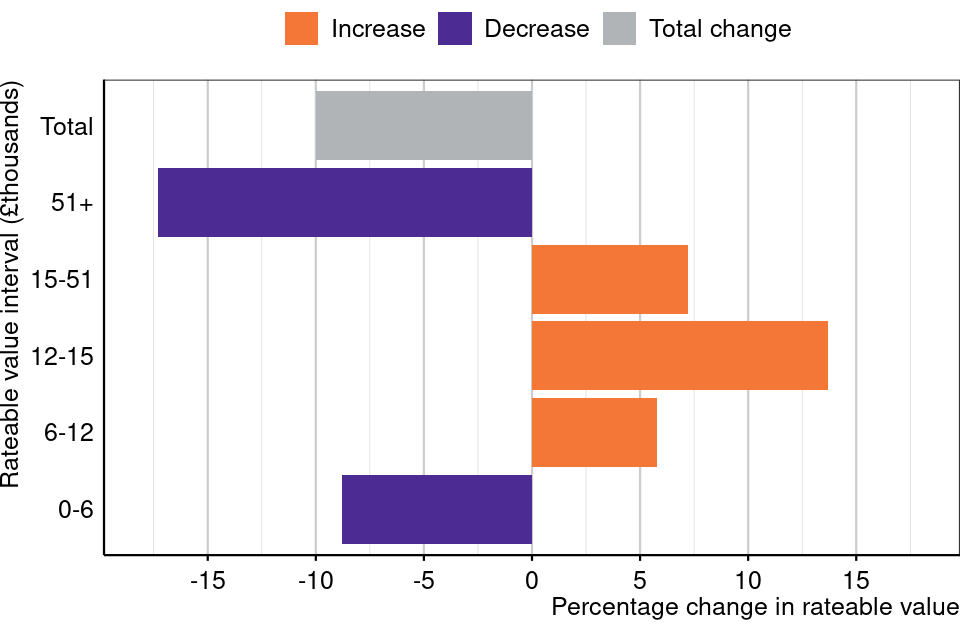
Figure 15: Percentage change in rateable value by rateable value interval, retail sector, England and Wales
Source: NDR Revaluation 2023 (draft list), published November 2022 (Table 3.1)
Figure 15 compares percentage changes in total rateable value for each rateable value interval with the total percentage change in rateable value for the retail sector in England and Wales.
10. Change within the industry sector
This section breaks down the industry sector by the SCat codes assigned to it and by intervals of rateable value.
Figure 16: Total rateable value for 2023 draft and 2017 local rating lists, industry sector by Special Category (SCat) code description, England and Wales
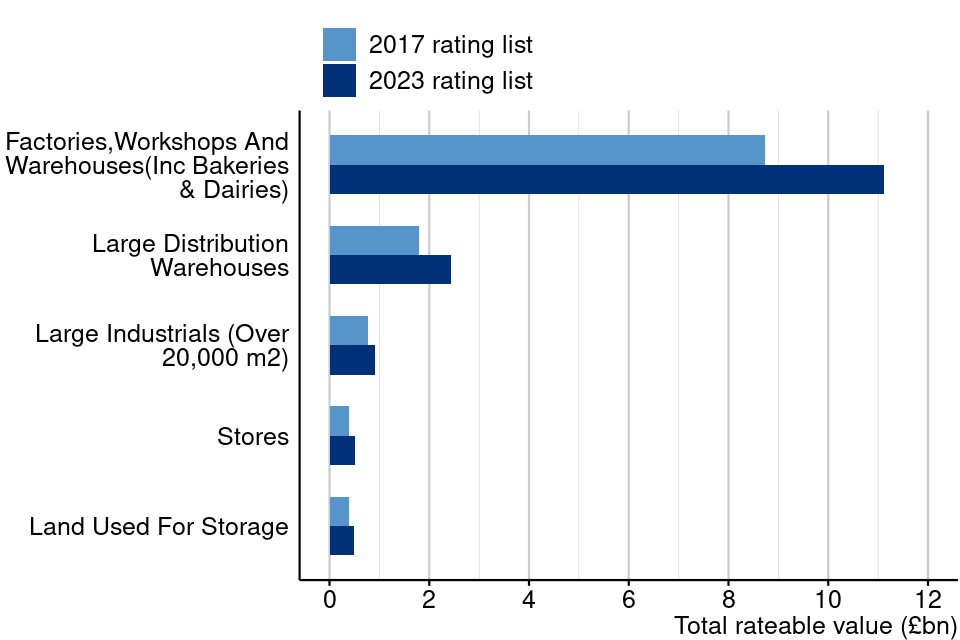
Figure 16: Total rateable value for 2023 draft and 2017 local rating lists, industry sector by Special Category (SCat) code description, England and Wales
Source: NDR Revaluation 2023 (draft list), published November 2022 (Table 4.0)
Figure 16 compares total rateable value on the 2017 rating list and draft 2023 rating list for the five Special Category (SCat) codes with the greatest total rateable value within the industry sector.
Figure 17: Change in rateable value (£billions) by rateable value interval, industry sector, England and Wales

Figure 17: Change in rateable value (£billions) by rateable value interval, industry sector, England and Wales
Source: NDR Revaluation 2023 (draft list), published November 2022 (Table 3.2)
Figure 17 compares changes in total rateable value (£billions) for each rateable value interval with the total change in rateable value for the industry sector in England and Wales.
Figure 18: Percentage change in rateable value by rateable value interval, industry sector, England and Wales
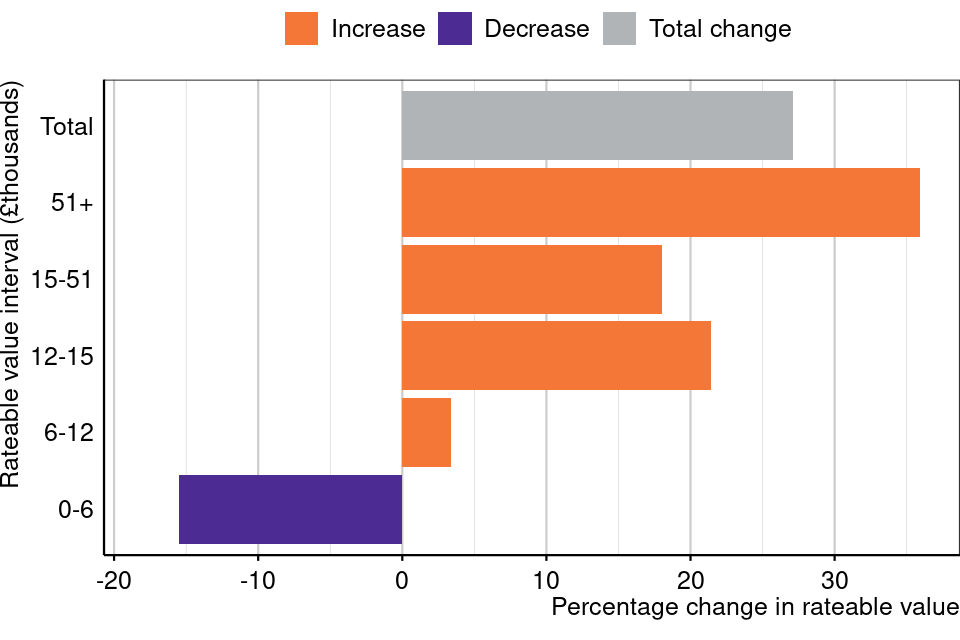
Figure 18: Percentage change in rateable value by rateable value interval, industry sector, England and Wales
Source: NDR Revaluation 2023 (draft list), published November 2022 (Table 3.2)
Figure 18 compares percentage changes in total rateable value for each rateable value interval with the total percentage change in rateable value for the industry sector in England and Wales.
11. Changes within the office sector
There are only two Special Category (SCat) codes within the office sector: offices (including computer centres) and offices headquarters/institutional. Offices (including computer centres) make up the vast majority of both properties and rateable value in the office sector. There are no notable differences between the percentage increase in rateable value for the two SCat codes.
This section breaks down the office sector by intervals of rateable value.
Figure 19: Change in rateable value (£billions) by rateable value interval, office sector, England and Wales

Figure 19: Change in rateable value (£billions) by rateable value interval, office sector, England and Wales
Source: NDR Revaluation 2023 (draft list), published November 2022 (Table 3.3)
Figure 19 compares changes in total rateable value (£billions) for each rateable value interval with the total change in rateable value for the office sector in England and Wales.
Figure 20: Percentage change in rateable value by rateable value interval, office sector, England and Wales

Figure 20: Percentage change in rateable value by rateable value interval, office sector, England and Wales
Source: NDR Revaluation 2023 (draft list), published November 2022 (Table 3.3)
Figure 20 compares percentage changes in total rateable value for each rateable value interval with the total percentage change in rateable value for the office sector in England and Wales.
12. Changes within the other sector
The ‘other’ category was created to cover Special Category (SCat) codes which could not be readily assigned to ‘retail’, ‘office’ or ‘industry’. This includes hereditaments which fall under:
-
education
-
health
-
transport
-
leisure
-
accommodation
-
utilities
This sector also includes some SCat codes which are associated with retail, industry or offices, but do not directly fall into these sectors for valuation purposes and are therefore grouped into the ‘other’ categories.
These SCat codes are grouped in sub-sectors:
-
‘Other – retail’
-
‘Other – storage and distribution’ (an industry sub-sector)
-
‘Other – offices’
There is also an ‘other – other’ sub-sector, which contains all remaining SCat codes that do not fit into a specific sector or sub-sector. For more information on these sub-sectors, please see Tables 4.0 to 4.2 of this release. This section breaks down the ‘other’ sector by sub-sector.
Figure 21: Total rateable value for 2023 draft and 2017 local rating lists, ‘other’ sector by sub-sector, England and Wales

Figure 21: Total rateable value for 2023 draft and 2017 local rating lists, 'other' sector by sub-sector, England and Wales
Source: NDR Revaluation 2023 (draft list), published November 2022 (Table 4.0)
Figure 21 compares total rateable value on the 2017 rating list and draft 2023 rating list for each sub-sector in the ‘other’ sector. The assembly and leisure sub-sector is the largest in the ‘other’ sector in terms of rateable value. This sub-sector includes:
-
hospitality (such as pubs, cafes and restaurants)
-
sports and leisure facilities
-
museums
-
entertainment venues (such as cinemas and theatres).
Figure 22: Change in rateable value (£billions) by rateable value interval, ‘other’ sector, England and Wales
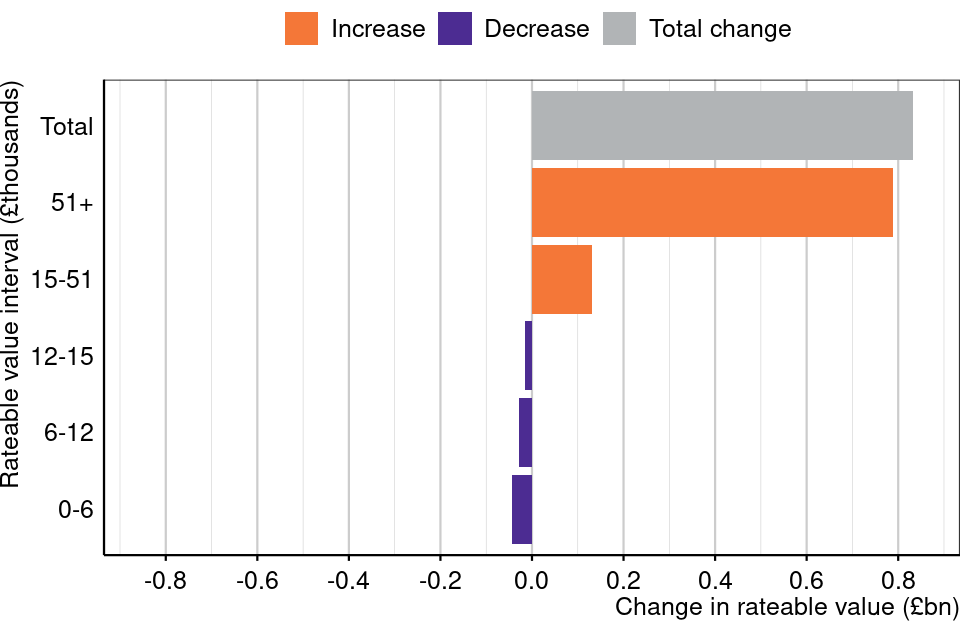
Figure 22: Change in rateable value (£billions) by rateable value interval, 'other' sector, England and Wales
Source: NDR Revaluation 2023 (draft list), published November 2022 (Table 3.4)
Figure 22 compares changes in total rateable value (£billions) for each rateable value interval with the total change in rateable value for the ‘other’ sector in England and Wales.
Figure 23: Percentage change in rateable value by rateable value interval, ‘other’ sector, England and Wales
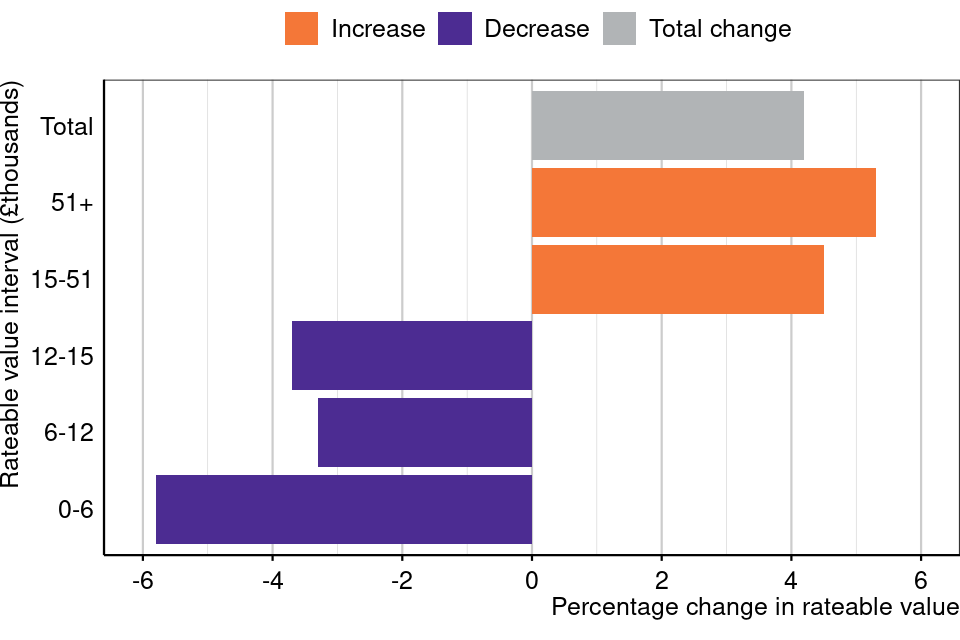
Figure 23: Percentage change in rateable value by rateable value interval, 'other' sector, England and Wales
Source: NDR Revaluation 2023 (draft list), published November 2022 (Table 3.4)
Figure 23 compares percentage changes in total rateable value for each rateable value interval with the total percentage change in rateable value for the ‘other’ sector in England and Wales.
13. Background on business rates and revaluation
Business rates are a tax on non-domestic property. If a property is used as a business or for purposes which are not domestic, it is likely to be rateable.
The Valuation Office Agency (VOA) is required, by the Local Government Finance Act 1988, to compile and maintain rating lists specifying a rateable value (RV) for each relevant non-domestic rateable property (also known as a hereditament) in England and Wales. These rateable values provide the basis for national non-domestic (business) rates bills, which are calculated and issued by local billing authorities.
The RV of a property is broadly based on the annual rent for which a rateable property could have been let on the open market at a set date. It is based on a range of factors including use, location, and age, but a major determinant of rental value is the size of the property.
Non-domestic rateable properties fall into either a local rating list or a central rating list. There is a single local rating list for each billing authority in England and Wales, and there are two central rating lists, one for England and one for Wales.
The central rating lists contain the rating assessments for the network property of major transport, utility and telecommunications undertakings and cross-country pipelines. There is a single entry in one of the rating lists (either for England or Wales) for each company named in the Central Rating List Regulations 2005. There are separate regulations and lists for England and Wales.
Rates on central rating list rateable properties in England are paid directly to the Department for Levelling up, Housing and Communities, and in Wales to the Welsh Government.
13.1 Revaluation
A revaluation is an update of the rateable values of all business, and other non-domestic property, in England and Wales at a particular point in time. Rateable values are used to calculate business rates bills.
Valuations are based on the open market rental value on a single date, 1 April 2021, known as the Antecedent Valuation Date (AVD). They will be used by local authorities, along with the multiplier and any reliefs a ratepayer qualifies for, to calculate and issue business rates bills from 1 April 2023.
The VOA is required to regularly undertake a revaluation to make sure that rateable values reflect changes in the property market. Rateable values reflect open market rental values at a fixed date – if market values have changed, then rateable values will change with them.
Revaluations are necessary because the relative value of properties changes over time. Rents will increase in some locations, and for some types of properties, over time, and they will fall or stay the same for others. Rateable values will reflect this.
14. Data information, methodology and quality
These statistics are released as part of the VOA’s commitment to make data more accessible, as well as continuing to improve and make more consistent the presentation of information to assist users conducting their own analysis of VOA data. The data are used to inform government policy and conduct analyses to support the operations of the VOA.
This release includes the following tables in excel and csv format:
-
percentage change in rateable value from 2017 to 2023 Local Rating List by region and sector (Table 1.0)
-
change in rateable value from 2017 to 2023 Central Rating List (Table 1.1)
-
change in rateable value from 2017 to 2023 Local Rating List by administrative area and sector (Tables 2.0 to 2.4)
-
distribution of rateable properties and value across rateable value interval by country and region and sector (Tables 3.0 to 3.4)
-
change in rateable value from 2017 to 2023 Local Rating List by Special Category (SCat) for England and Wales (Tables 4.0 to 4.2)
-
change in rateable value from 2017 to 2023 Local Rating List by property type for England and Wales (Tables 5.0 to 5.2)
A metadata lookup table is available on the release page in csv format.
The information supplied in the tables is based upon linking properties between the 2017 rating lists and draft 2023 rating lists. The current assessment (rateable value) of a property according to the 2017 rating list is compared with the proposed assessment according to the draft 2023 rating list.
This information is produced using administrative data held within the VOA’s operational database. All administrative data are subject to processing and process errors and as such, while the VOA has made every effort to ensure accuracy of the data underpinning this publication, it is possible that some errors remain.
The statistics presented in this release are consistent with the draft list published on 17 November 2022, the data for which were generated on 12 November 2022. In the period from draft list publication and the final compiled list going live on 1 April 2023 changes will be made to the draft list as part of “dual list maintenance” largely reflecting changes to the current 2017 list, as reported in the quarterly NDR Challenges & Changes official statistics.
The sources and definitions used are consistent with VOA’s existing statistical publications regarding non-domestic rates.
Our quality assurance follows the approach set out in the VOA Quality Policy.
15. Confidentiality
Access to the data and release prior to the day of its publication is limited to the statistics production team and named valuation experts to assist with quality assurance.
16. Glossary
Area code – a unique identifier for administrative geographies as specified by the Office for National Statistics (ONS).
Assessment – an entry in the rating list is often referred to as an assessment.
Antecedent Valuation Date (AVD) – valuations are based on the open market value on a single date, known as the Antecedent Valuation Date (AVD). The AVD for the 2023 revaluation is 1 April 2021.
Billing authority (BA) – a local authority empowered to collect non-domestic rates on behalf of itself and other local authorities in its area. In England, shires, metropolitan districts, the Council of the Isles of Scilly, unitary authorities, London boroughs and the City of London are BAs.
Billing authority code – a unique identifier for BAs.
Central rating list – the VOA’s list of rateable values for companies named in the Central Rating List Regulations, primarily for the network property of major transport, utility and telecommunications undertakings and cross-country pipelines. There are separate lists for England and Wales.
Compiled list – the rating list as it comes into effect following revaluation. For the 2017 rating list it is the list as at 1 April 2017. For the 2023 rating list, this will be 1 April 2023.
Draft list – a draft rating list is made available in the months ahead of a revaluation.
Local rating list(s) – the VOA’s lists of all the non-domestic rateable properties in England and Wales. There is a separate local list for each BA.
Property type – each property on the non-domestic rating list is assigned a ‘primary description’. A primary description code is more generic than a SCat code (see below) and shows the nature of the use of the rateable property. Common primary descriptions are grouped together to form ‘property type’. There are six broad property types and 35 more detailed property types as shown in Tables 5.0 to 5.2.
Rateable property (also known as hereditament) – a unit of non-domestic property that is, or may become, liable to non-domestic rating and thus appears in the local rating list. The area of a property included in a rateable value calculation can cover all of one property, only part of a property or be several separate units in one building or site.
Rateable value (RV) – a monetary value assigned to every rateable property within a rating list, broadly based on the annual rent for which a rateable property could have been let on the open market at a set date.
Rating lists – each BA has their own local rating list. There are also two central rating lists, one for England and one for Wales.
Region – a geographical unit formerly referred to as Government Office Region (GOR). The GOR framework was the primary classification for regional statistics and comprised nine regions of England, which, combined with the devolved administrations, collectively spanned the United Kingdom. From 1 April 2011 the term GOR was dropped in favour of region. This release comprises English regions and Wales.
Revaluation – a revaluation is an update of the rateable values of all business, and other non-domestic, property in England and Wales at a particular point in time. Previous revaluations took place in 2010 and 2017. This revaluation take effect on 1 April 2023.
Sector – a sector consists of the following categories: retail, industrial and office (RIO), which is a categorisation commonly used by those in the surveying profession. VOA statisticians have, in conjunction with operational colleagues, mapped each SCat code to one of the three categories. The ‘other’ category was created to cover SCat codes which could not be readily assigned to retail, office or industry.
Sub-sector – in addition to the four sectors, the SCat codes have also been mapped to 18 sub-sectors, within the overall retail/office/industrial/other categories.
Special category (SCat) code – each property on the non-domestic rating list is assigned a SCat code, which is an operational code used by the VOA to classify a property’s use for administrative purposes. A SCat code details the basis on which the property was rated.
Over 350 SCat codes are in use. Common property types are grouped together into sectors or sub-sectors as shown in Tables 4.0 to 4.2
17. Further Information
The 2023 rating lists will take effect from 1 April 2023. We will update these statistics in April 2023.
We welcome feedback from users on the usefulness of the information provided in this summary. Please forward any comments to the Statistics Inbox.
